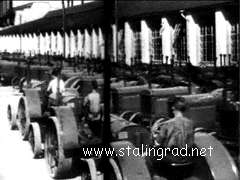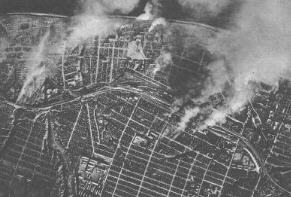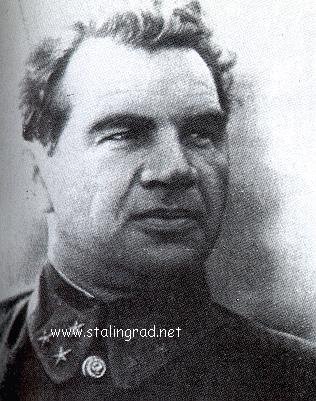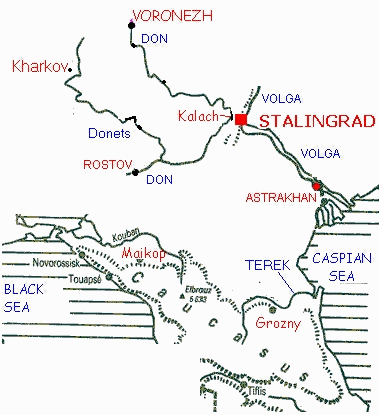|
Stalingrad -
Astrachan - Army Group B
Stalingrad was a
large industrial city producing armaments and tractors, it
stretched
for 30 miles along the banks of the Volga River.

Tractor-factory at Stalingrad.
Army Group B
consisted of 6th Army, under Paulus ( 2 panzer, 1 motorised
infantry
and 15 infantry divisions ) and Group von Weichs, under von
Weichs ( 1 motorised
infantry, 4 German and 2 Hungarian infantry divisions ), 2nd
Hungarian Army, under
Jany ( 4 Hungarian infantry divisions ) and 4th Panzer Army,
under Hoth. (3 panzer,
2 motorised infantry and 6 infantry divisions ).
Part
of directive #45 :
"The task
of Army Group B is, as previously laid down, to develop the Don
defenses
and, by a thrust forward to Stalingrad, to smash the enemy
forces concentrated
there, to occupy the town, and to block the land
communications between the Don
and the Volga, as well as the Don itself. Closely connected
with this, fast-moving
forces will advance along the Volga with the task of
thrusting through to Astrakhan
and blocking the main course of the Volga in the same way.
These
operations by Army Group B will be known by the cover name
"Heron"."
6th Army faces 4
Russian armies, 21th, 62nd, 63th and 64that the Russian
bridgehead
across the Don at Kalach. Also the first and the 4th Russian
Panzer Army. The 4th
Panzer Army are ready to encircle XIVth German Panzer Corps.
Fifty-first Army corps
of General Von Seydlitz-Kurzbach is in a dangerous position. It
is short of ammunition
and fuel. Infact the complete 6th Army is short of munition and
fuel. Because Hitler
divided Army Group South in two smaller armies and these two
smaller armies are
marching away from each other, the supply-lines are too long.
Also the organisation
of the supply-lines needs too much time. The Germans are losing
valuble time in their
race to the Volga.(Stalingrad) Hitler's adjudant, Major Engel,
is visiting Weichs
and Paulus. They both explain that 6th Army is too weak for jobs
assigned to them.
They are not able to withstand strong counterattacks.
As Jodl said and
as Halder said six days before, Hitler takes away 4th Panzer
Army
from the Caucasusfront to Army Group B. He's ordering Hoth to
attack the Kalachfront
at Stalingrad. Hitler now understands that 6th Army is not
strong enough to capture
the Stalingrad area.
Order of
battle of the German 6th Army - 12 augustus 1942
24th Panzer
Corps
16th Infantry Division
295th Infantry Division
51st Army
Corps
44th Infantry Division
71st Infantry Division
11th Army
Corps
100th Jaeger Division with Croatian Regiment 369
14th Panzer
Corps
60th Motorized Infantry Division
16th Panzer Division
3rd Motorized Infantry Division
8th Army
Corps
384th Infantry Division
305th Infantry Division
389th Infantry Division
376th Infantry Division
17th Army
Corps
22nd Panzer Division
Italian "Celere" Division with Bers. Regiment 6
79th Infantry Division
113th Infantry Division
The Germans
attacking to take the Don river bridge at Kalach. By the end of
August the 4th Army's northeastward advance against the city was
converging with the eastward advance of the 6th Army, under
General Friedrich Paulus,
with 330,000 of the German Army's finest troops. The Red Army,
however, put up the
most determined resistance, yielding ground only very slowly and
at a high cost as
the 6th Army approached Stalingrad. On August 23 a German
spearhead penetrated
the city's northern suburbs, and the Luftwaffe rained incendiary
bombs that destroyed
most of the city's wooden housing.

The luftwaffe is bombing Stalingrad.
The Soviet 62nd
Army was pushed back into Stalingrad proper, where, under the
command of
Vasily I. Chuikov, it made a determined stand.
 I I
Vasily I. Chuikov
Meanwhile, the
Germans' concentration on Stalingrad was increasingly draining
reserves
from their flank cover, which was already strained by having to
stretch so far 400 miles
-640 km on the left (north), as far as Voronezh, 400 miles-640
km again on the right
(south), as far as the Terek River (Caucasus).

From Voronezh to the Terek River.
A 800 miles - 1280 Km frontline.
By mid-September
the Germans had pushed the Soviet forces in Stalingrad back
until
the latter occupied only a nine-mile-long strip of the city
along the Volga, and this
strip was only two or three miles wide. The Soviets had to
supply their troops by
barge and boat across the Volga from the other bank. At this
point Stalingrad became
the scene of some of the fiercest and most concentrated fighting
of the war; streets,
blocks, and individual buildings were fought over by many small
units of troops and
often changed hands again and again.
ers had their
The most critical moment came on October 14, when the Soviet
defenders had their
bk so close to the Volga that the few remaining supply crossings
of the river came
under German machine-gun fire. The Germans, however, were
growing dispirited by
heavy losses, by fatigue, and by the approach of winter.
In the factories,
German troops battle through workhalls and narrow streets.
Armored
vehicles are trapped and disabled by Soviet anti-tank guns that
fire at point-blank
range from the rubble. The 6th Army is rapidly becoming
exhausted. 6th Army has
inched its way forward to the point where it is now in control
of more than 90% of
the city.
There was no
compelling military reason in the battle for the Soviet Union
during
World War II why the German army should have bothered with
capturing the
Soviet city of Stalingrad. When it didn't fall quickly, they
probably should have just
guarded it and continued toward the Soviet oilfields of Baku.
But for some
reason Hitler became mesmerized by this little town on the Volga
River,
and insisted upon attack after attack upon it. Maybe it was
because the town
was named after his arch-foe, Joseph Stalin.
In any case, the
Russians held on tenaciously and the fighting was ferocious.
Hundreds of thousands were killed.
While the Germans
exhausted themselves for a few bits of worthless ground the
Russians were building a huge army on their side of the Volga
River.
On November 20,
the Soviet army struck not the Germans, but their weaker
Romanian allies on either side of the city. The Romanians
collapsed and the
Soviets surrounded the German Sixth Army.
Friedrich Paulus,
the commander of 6th Army wanted to break out of the
encirclement,
but German dictator Adolf Hitler forbad it. The air force,
he said, would keep the
army supplied.
But it couldn't,
and the rest of the German army could not break back into
Stalingrad
to rescue the surrounded army. The Sixth Army starved and froze
and in January
1943 it surrendered, despite Hitler's orders.
It was a great
victory for the Soviet Union and a national tragedy for Germany.
It was also the turning point on the Eastern Front. From that
point on the
Germans were generally on the defensive and the Soviets on the
offensive.
|